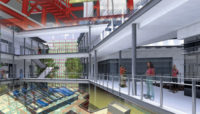
A VRF system installed in this University of
Hawaii dorm helped the school achieve LEED® certification and lower energy costs.
Founded in 1907, the University of Hawaii at Manoa (UH-M) is the flagship campus of the University of Hawaii. Students and faculty come from around the world to take advantage of UH-M’s research opportunities, diverse community, Division I athletics program, and beautiful landscape. However, the university’s student housing had become a bit dated - since none had been built since the 1970s.
When officials at the UH-M sought an image change to improve on-campus student housing and the campus community itself, they determined massive upgrades were necessary. For years, students complained about the on-campus housing conditions, and one of the worst offenders was Frear Hall. Thus, a new version was planned as part of a $132 million dormitory renovation and construction project.
University administrators decided to construct a new 12-story facility including 810 beds. The original structure was demolished in 2006 to make room for the new $71 million Frear Hall. From the outset, offering A/C was a high priority. Yet at the same time, environmental friendliness was a key objective, and LEED® certification was also vital.
A UNIVERSITY FIRST
Frear would be the first new dormitory in 30-plus years, and it would also be one of the only ones with air conditioning. Notkin Hawaii Inc. served as the project’s mechanical engineer, and according to the firm’s Keith M. Chan, P.E., the university sought an A/C system to provide climate comfort at an economical cost, with the ability to maintain proper cooling and dehumidification.The university also wanted the ability to submeter (thus monitor) each fancoil unit’s A/C usage for educational purposes and/or to charge the students appropriately. “Having each bedroom’s A/C consumption monitored was required and was a challenge, and the A/C system chosen had the capability to do this,” Chan said.
The project developer, American Campus Communities (ACC) sought an A/C system to provide a central point of control and a remotely accessible control system. This was required to facilitate future system troubleshooting and diagnostics as well as for overall HVAC control with the goal of increasing operational efficiencies and lowering energy consumption.
Xavier Garcia, vice president of project management for ACC, explained Notkin and CTG Energetics (the project’s LEED consultant) were collectively tasked with investigating systems compatible with this plan while also adhering to the LEED criteria. Swinerton Builders – Hawaii also teamed with ACC to select the designer consultants and present the winning proposal to the university.
After exhaustive research, the Daikin two-pipe VRV heat pump systems were selected. What made the Daikin system so well suited for the project, according to Swinerton’s senior project manager Silas Collier, was not only its high level of efficiency and control but also its small footprint.
“To provide the same amount of cooling to over 600 rooms with a conventional system, would have required a large amount of ductwork running both horizontally and vertically throughout the building,” Collier said. “In a structure where every square inch was optimized, the routing within walls of small diameter refrigerant lines greatly simplified construction,” he added. The low-profile, wall-mounted fancoil unit in each room and compact air-cooled condensing units on the roof were also easy to transport and install.”
QUITE SIMPLY, INTELLIGENT ENERGY MANAGEMENT
Another integral part of the project’s energy efficiency equation was Daikin’s Intelligent Manager III, which, like all of Daikin’s multi-zone control products, offers independent operational aspects.“All space temperature control demand and requirements are managed at the local level between the students’ A/C unit and the outdoor condensing unit supplying it with refrigerant,” said Daikin project manager, Robert Giba. “The Intelligent Manager control system is aware of these demands and requirements; however, it only reacts to enforce other changes or adjustments when specific parameters or boundaries are exceeded,” he added.
The UH-M staff also has access to the Intelligent Manager III system through both their intranet and internet connections as well as via a detailed e-mail reporting function.
In conjunction with the control system, the owner selected the Power Proportional Distribution (PPD) option, which apportions total outdoor unit power consumption back into the respective indoor units served by those outdoor units. PPD mathematically calculates each indoor unit’s portion of the outdoor unit’s total power consumption based upon its return air temperature, electronic expansion valve position, and baseline values determined by the factory.
DORMITORY RECEIVES THE SILVER
Ultimately, UH-M will use this calculated power consumption data to help students understand their individual consumption of the A/C resources. But the main Intelligent Manager III energy management function employed on this project is the temperature setpoint limitation feature.Maritas Calad, vice president of Norman S. Wright, explains, “This feature prevents the individual wall-mounted air conditioners from accepting any cooling temperature setpoint value below 73°F. This feature alone provides enormous energy savings and reduced equipment wear.”
The Daikin system combined with other energy-saving measures, and the building, which opened in August 2008 to full occupancy, received LEED Silver Certification.ES


